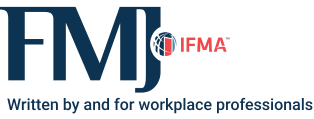AI Agents in FM
Transforming knowledge into action

Facility managers face a familiar problem: critical knowledge is scattered across manuals, PDFs, emails and databases. Operational systems — from vendor portals to building management systems (BMS) and IoT sensors — hold valuable real-time data, yet frontline teams often lack the time or tools to locate and apply this information when it matters most. The outcome is predictable: delayed resolutions, repeated questions, inefficiencies and higher operating costs.
Research consistently shows knowledge workers spend up to 20 percent of their time searching for information. In the FM context, wherein speed and accuracy directly impact costs, service levels and compliance, these inefficiencies compound. They also affect broader goals. Buildings account for roughly 40 percent of global energy use, so operational delays and poor data application influence both sustainability and resilience targets.
Defining AI agents in FM
In recent years, the term “AI agent” has entered industry discussions, often without clarity. In FM, the concept refers not to consumer chatbots but to intelligent systems that can:
-
Retrieve information from trusted sources,
-
Reason over it in context, and
-
Act within workflows to support or resolve requests.
The value of agents lies in combining information retrieval with actionability. For example, an AI agent may retrieve a relevant clause from a maintenance manual, verify it against a vendor record and draft a compliant response. In all cases, human oversight remains critical: escalation pathways, approval checkpoints and audit logs ensure accountability.
This perspective aligns with ISO 41001, the international management systems standard for FM. By framing AI adoption within established governance models, facility leaders can pursue innovation while preserving control and compliance.
How AI agents transform scattered documents and live data into actionable responses. The flow highlights retrieval from trusted sources, draft generation, human approval and auditable resolution.
From knowledge to action: A playbook
How can FMs move from theory to practice? A structured playbook helps ensure value and adoption.
Inventory & clean
The first step is identifying authoritative knowledge sources. Manuals, contracts, compliance documents and policy guidelines should be version-controlled, with redundant or outdated materials removed. Adding metadata — such as asset type, service line and risk level — improves retrieval accuracy.
Structure for retrieval
Knowledge is more usable when structured for clarity. Acronyms should be spelled out once and indexed. Glossaries, checklists and step-based cards for standard operating procedures (SOPs) reduce ambiguity. This preparation pays dividends: when an AI agent searches a knowledge base, it retrieves information that is consistent, current and actionable.
Resolution patterns
AI agents can deliver value by applying knowledge in common resolution scenarios:
-
Procurement clarification: Matching purchase orders, invoices and receipts (the classic three-way match) is time-consuming when exceptions arise. An AI agent can extract key fields, check alignment and draft a vendor clarification email, reducing accounts payable workload. Benchmarks suggest the average cost to process a single invoice remains close to US$9.87, with cycle times of around 10 days. Reducing exceptions has direct cost benefits.
-
Maintenance SOP retrieval: Technicians may need specific steps from equipment manuals. An agent can pull the correct section and attach it to a work order in a computerized maintenance management system (CMMS) or computer-aided facilities management (CAFM) tool, ensuring consistency and reducing errors.
-
Policy & compliance: When questions arise about safety or regulatory requirements, an agent can cite the relevant clause, provide the date of publication and log the citation for audit. Human oversight remains essential, but the process is faster and more dependable.
Connecting to live systems, safely
Static knowledge is only part of the FM landscape. Much of the value lies in connecting agents to live systems. These integrations should follow a principle of “read-first, write-later.”
-
CMMS/CAFM platforms: Agents can read open work orders or maintenance logs to provide context before drafting responses or recommendations.
-
Vendor portals & accounts payable systems: Reading transaction status or vendor data allows an agent to enrich communications and reduce delays.
-
BMS & IoT sensors: Building data such as temperature, humidity or occupancy informs responses to comfort complaints or energy deviations.
Open standards like BACnet demonstrate how integration can be achieved without vendor lock-in. The safest approach is phased: begin with read-only access, then allow controlled writing actions (e.g., creating a draft work order) with human approval. This minimizes IT disruption while unlocking new value.
At this stage, data security becomes critical. AI agents should follow four principles:
Governance, risk & global applicability
Innovation in FM must operate within clear governance frameworks. AI agents should follow three safeguards:
-
Source hierarchy: Only trusted documents or systems are used.
-
Explainable citations: Every response includes a reference to its source.
-
Red-flag categories: High-risk areas such as safety, finance or compliance always trigger human approval.
These guardrails ensure accountability and build trust across diverse geographies. By aligning with ISO 41001, organizations can deploy AI agents in ways that remain portable across regions and industries, avoiding local bias or overly narrow use cases.
ROI & KPIs that matter to leaders
Facility executives make decisions based on measurable outcomes. AI agents should be evaluated against clear performance indicators, including:
-
Time to resolution (TTR): Average time from request to closure.
-
First contact resolution: Percentage of issues resolved without reopening.
-
Accounts payable efficiency metrics: Cost per invoice (~$9.87 benchmark) and cycle time (~10 days) (APQC).
-
Policy citation accuracy: Proportion of responses linked to a verified source.
-
Rework or duplication rate: Percentage of requests reopened or repeated.
-
Energy or comfort incidents: Deviations in building performance traced to operational delays.
These KPIs translate directly into financial, operational and sustainability outcomes, providing facility leaders with a clear framework for assessing ROI.
AI agents connect to existing FM systems in a “read-first” mode, retrieving data from CMMS/CAFM, vendor portals, and BMS/IoT sensors. Initial integrations are read-only (dashed arrows). Optional write actions, such as creating work orders or drafting vendor notes, can later be enabled with human approval.
Case pattern snapshots
Although every organization is different, several recurring patterns illustrate the value of knowledge-driven agents:
-
Health care provider in Europe: A hospital network applied AI-driven knowledge retrieval for compliance questions, reducing average resolution time from 3 days to 1 day — a 65 percent improvement over a six-month pilot.
-
University in Asia: During semester peaks, invoice exceptions dropped by 30 percent after agents automated the preparation of vendor clarifications.
-
Corporate campus in North America: Comfort complaints tied to HVAC were addressed using sensor data integration. Agents drafted replies and routed tickets to the correct team, improving first-contact resolution by 20 percent across one year of requests.
These examples remain de-identified but demonstrate universal lessons: structured knowledge, safe integrations and clear governance deliver results across regions and industries.
Change management & staff adoption
Technology succeeds only if staff adopt it. Change management is therefore as important as technical design. Successful projects involve:
By engaging staff early and openly, organizations build trust and accelerate adoption.
Roadmap & pitfalls
Implementing AI agents in FM should follow a phased roadmap:
- Knowledge cleanup: Establish authoritative sources.
- Pilot a single workflow: Start small to build confidence.
- Integrate systems: Connect CMMS, vendor portals or sensors.
- Scale and govern: Expand coverage with clear escalation rules.
Pitfalls to avoid include rushing without knowledge preparation, over-automating without human oversight and neglecting change management. Success depends as much on organizational readiness as on technical design.
Conclusion
AI agents offer FMs a way to move beyond simple automation. By making both documents and live data immediately actionable, they transform knowledge into resolution. Structured correctly, they reduce inefficiencies, improve compliance and strengthen resilience across global operations.
The opportunity is clear: when knowledge stops sitting on the shelf and starts driving decisions, facilities management becomes faster, safer and more sustainable.
Key performance indicators (KPIs) facility leaders can use to measure the impact of AI agents, including operational efficiency, financial benchmarks, compliance and sustainability metrics.

Read more on Technology and Leadership & Strategy or related topics Strategic Planning and Training
Explore All FMJ Topics









